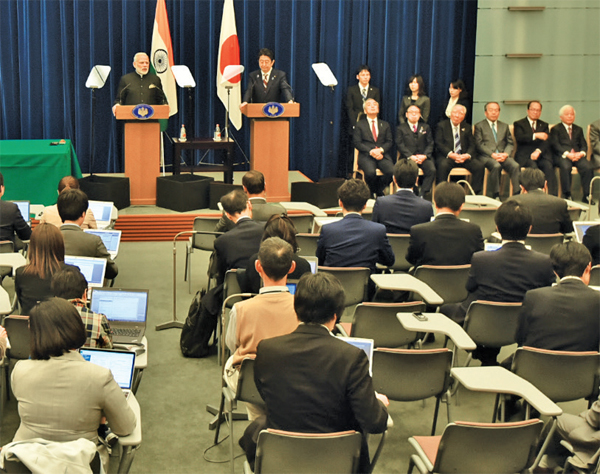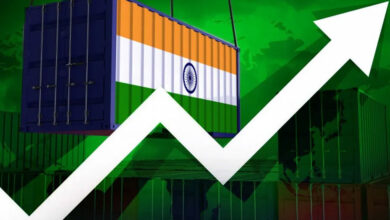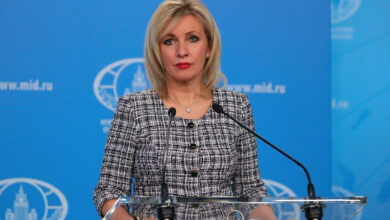India, Japan sign civil nuclear cooperation deal during PM’s Japan visit
 The India-Japan civil nuclear cooperation agreement, in the works for over six years, was finally signed during Prime Minister Narendra Modi’s visit to Japan on November 11 and 12, for the annual prime ministerial summit with Japan, a key feature of the India-Japan Special Strategic and Global Partnership. The Japan-India Nuclear Civil Agreement (NCA) opens, in theory, the way for the construction of six Westinghouse/ Toshiba AP1000 reactors at Mithivirdi, in the state of Gujarat.
The India-Japan civil nuclear cooperation agreement, in the works for over six years, was finally signed during Prime Minister Narendra Modi’s visit to Japan on November 11 and 12, for the annual prime ministerial summit with Japan, a key feature of the India-Japan Special Strategic and Global Partnership. The Japan-India Nuclear Civil Agreement (NCA) opens, in theory, the way for the construction of six Westinghouse/ Toshiba AP1000 reactors at Mithivirdi, in the state of Gujarat.
While basic parameters of the long-awaited civil nuclear deal were agreed upon by the two Prime Ministers in 2015, the final concessions were made barely hours before Mr Modi reached Tokyo.
Sources told India Strategic that the agreement is “broadly the same” as the civil nuclear agreements India has with other countries, including the landmark Indo-US civil nuclear deal of 2008. However, India had made concessions, taking into account “Japan’s Special sensitivities”, as the only country ever to have suffered a nuclear attack.
“It follows the same template, but compresses the developments which have taken place since 2007,” a source said. “It reflects commitments which were made at the time of the NSG (Nuclear Suppliers Group) waiver in 2008, many of which were unilateral in nature (including not conducting further nuclear tests),” said the sources.
“The termination clause is there in other NCAs we have signed, including with the US (Article 14). However, the circumstances triggering a possible termination are never sharply defined,” the source told India Strategic, responding to a specific question about whether India had agreed to a “nullification clause”.

“Consideration has to be given to mitigating factors. Given Japan’s special sensitivities as the only nation to have suffered a nuclear attack, it was felt that their views should be recorded in a separate note,” sources said, adding that “no additional commitments have been made by India.”
The Note is a record, being kept by the negotiators of their respective views.
“It states what could be Japan’s views in advance, on what is a hypothetical situation (India conducting a nuclear test); that is their national prerogative,” sources said. “At the same time, it also records India’s position on the same issue, which is a reiteration of the September 2008 commitments (for the NSG waiver). No change is envisaged from those commitments,” sources reiterated.
The joint document signed by the two countries lays down a roadmap for bilateral cooperation in the field of nuclear energy. “This would provide for the development of nuclear power projects in India and thus strengthening of energy security of the country. The present agreement would open up the door for collaboration between Indian and Japanese industries in our Civil Nuclear programme,” it says.
However, getting signatures on the dotted line was not easy. There were several questions and concerns that delayed the agreement, some of which remain. Policy-makers and parliamentarians in Japan argued that a nuclear agreement with India, a non-signatory to the Nuclear Non-proliferation Treaty (NPT) and the Comprehensive Test Ban Treaty (CTBT), would undermine the nuclear regime.
Addressing those concerns, Japanese Prime Minister Shinzo Abe said, “This agreement is a legal framework that India will act responsibly in peaceful uses of nuclear energy and also in the non-proliferation regime, even though India is not a participant or signatory of the NPT. It (the agreement) is in line with Japan’s ambition to create a world without nuclear weapons,” Prime Minister Abe said.
Defence cooperation and maritime security was another key issue addressed.
A joint statement issued after the talks between the two delegations stressed the role of India and Japan for stability and prosperity in the Indo-Pacific region, with the two Prime Ministers reiterating the need to further consolidate their security and defence cooperation.
“They welcomed the entry into force of the two Defence Framework Agreements concerning the Transfer of Defence Equipment and Technology and concerning Security Measures for the Protection of Classified Military Information. They underscored the need to further expand defence engagement through greater two-way collaboration and technology cooperation, co-development and co-production, by expediting discussions for determining specific items including through the Joint Working Group on Defence Equipment and Technology Cooperation,” the joint statement said.
“The two Prime Ministers appreciated the successful Annual Defence Ministerial Dialogue held in New Delhi, Japan’s regular participation in the Malabar Exercise and the International Fleet Review off the coast of Vishakapatnam. They reaffirmed their desire to further deepen bilateral security and defence dialogues, through the “2+2” Dialogue, Defence Policy Dialogue, Military-to-Military Talks and Coast Guard-to-Coast Guard co-operation,” the joint statement said.
With the inaugural air force staff talks held earlier this year, both countries now have institutional wide ranging dialogue mechanism in place covering all three services. The two Prime Ministers plan to expand dialogue and cooperation in the defence sector to cover exchange of observers in humanitarian assistance and disaster relief (HA/DR) exercises, and exchange and training of personnel in other fields.
While there was no deal on the purchase of the US-2i ‘ShinMaywa’ search and rescue aircraft, “Prime Minister Modi conveyed his appreciation for Japan’s readiness to provide its state of the art defence platforms such as US-2 amphibian aircraft. It symbolises the high degree of trust between the two countries and the distance that Japan and India have covered in advancing their bilateral defence exchanges,” the statement said.

In what will definitely not be welcomed by China, “the two Prime Ministers underscored the rising importance of the Indo-Pacific region as the key driver for the prosperity of the world. They stressed the core values of democracy, peace, the rule of law, tolerance, and respect for the environment in realising pluralistic and inclusive growth of the region. In this context, Prime Minister Abe appreciated Prime Minister Modi’s active engagement in the region under the “Act East Policy,” and briefed Prime Minister Modi on the “Free and Open Indo-Pacific Strategy.” Prime Minister Modi appreciated Japan’s greater engagement in the region under this strategy. They recognised the potential for deeper bilateral cooperation and synergy between the said policy and strategy,” the joint statement said. “They further stressed that improving connectivity between Asia and Africa, through realising a free and open Indo-Pacific region, is vital to achieving prosperity of the entire region. They decided to seek synergy between India’s “Act East” Policy and Japan’s “Expanded Partnership for Quality Infrastructure,” by closely coordinating, bilaterally and with other partners, for better regional integration and improved connectivity as well as industrial networks based on the principles of mutual consultation and trust.”
Japan’s National Security Advisor Shotaro Yachi visited India November 5 for bilateral consultations with India’s National Security Advisor Ajit Doval, during which they firmed up the agenda for the Indian Prime Minister’s visit and discussed India’s renewed interest in buying the US-2i ShinMaywa amphibious search-and-rescue (SAR) aircraft from Japan.
India has been keen to acquire a dozen of these marine reconnaissance aircraft but, despite five years of negotiations, some details of pricing need to be worked out before the billion dollar plus deal can be finalised. Beijing is sure to be closely watching the outcome of the Indian Prime Minister’s visit to Tokyo. It has already objected to reported Japanese offers to lower the sale price for India, calling it “disgraceful.”
During their discussions, the two NSAs shared a view that “the Special Strategic and Global Partnership between India and Japan, that was agreed to during the visit of Prime Minister Modi to Japan in August-September 2014, is a key partnership for promoting peace, prosperity and development in the region and the world. Their discussions, which were centred on important issues covering bilateral, regional and global dimensions, helped to further underscore the commonalities of views, shared interests and need to promote universal values. NSA Yachi conveyed Japan’s continued commitment to enhance Japan’s engagement with India on regional and global issues,” said a statement issued by the MEA.
Mr Modi had an audience with the Emperor of Japan while in Tokyo for the third Annual Summit meeting between him and PM Abe. Increased collaboration in space and enhanced skills development, and raised Japanese investments in Indian infrastructure, particularly the railways, were among other significant outcomes of the summit.
During PM Modi’s visit in August-September 2014 to Japan, the first bilateral visit outside India’s immediate neighbourhood that PM Modi undertook, the relationship was upgraded to a ‘Special Strategic and Global Partnership’.
Mr Kenji Hiramatsu, Japan’s Ambassador to India, said Japan was looking at some ”concrete” action with India in the realm of maritime security, while he expressed concern over recent developments in the South China Sea (SCS).
China, which lost an international arbitration case over its claims over the SCS, is locked in a series of territorial disputes with Japan and other littoral states including the Philippines and Vietnam and has even taken some aggressive, even hostile measures to bolster its claims.
India and Japan have an established mechanism to discuss maritime issues as they both seek that “the status quo in the maritime domain should not be changed militarily and every nation should follow the international laws of the sea”, Mr Hiramatsu said.
”We are trying to understand the situation. We do not have specific plans at the moment, but eventually we may identify some concrete action,” Mr Hiramatsu said when asked how the maritime mechanism was working.
Japan also wants India to be part of its Indo-Pacific initiative, which Prime Minister Abe articulated at the sixth Tokyo International conference on African Development (TICAD) in August at Nairobi, the first outside Japan since the launch of the initiative in 1993.
”Japan bears the responsibility of fostering the confluence of the Pacific and Indian Oceans and of Asia and Africa into a place that values freedom, the rule of law, and the market economy, free from force or coercion, and making it prosperous,” Mr Abe said at the sixth TICAD in August, spelling out his new diplomatic strategy for the Indo-Pacific Ocean region, to counter Beijing’s aggressive stance in the region.
The Japanese Ambassador said Prime Minister Abe briefed Prime Minister Modi about the Indo-Pacific initiative and sought his views on how to give the initiative shape when they recently met at Laos.
The initiative concerns ways to connect Japan, India and Africa in the maritime space, and how to ensure continuous connectivity and freedom of navigation along trade routes.
”We are concerned over the developments in South China Sea, and the unilateral building activities in islands of the (South China) Sea is not acceptable to us,” Mr Hiramatsu said.
The Indo-Japanese joint statement in December last year, issued after Mr Abe’s visit to India, had mentioned the South China Sea for the first time.
”In view of the critical importance of the sea lanes of communications in the South China Sea for regional energy security and trade and commerce which underpins continued peace and proprietary of the Indo-Pacific, the two Prime Ministers called upon all states to avoid unilateral actions that could lead to tension in the region,” the 2015 statement said.
Both India and Japan have outstanding territorial disputes with China; India along the Line of Actual Control or land boundary with China, while
Tokyo has a dispute with Beijing over islands in the East China Sea.
Tokyo was keen to collaborate with New Delhi on the Chabahar project, which would provide India connectivity to Central Asia via Afghanistan. India, Iran and Afghanistan have already signed an agreement to develop the port town and routes of connectivity. The strategically located Chabahar project in Iran could serve as a strategic option for India as a counterweight to China’s presence at Gwadar in Pakistan’s Balochistan province.
”Chabahar has great strategic importance as it would connect south Asian countries to Central Asia and Turkey through Afghanistan. Japan can certainly help the countries developing the project,” Ambassador Hiramatsu also said.
Every aspect of the Indian Prime Minister’s visit to Japan, a “natural ally” was very closely monitored in Beijing.





